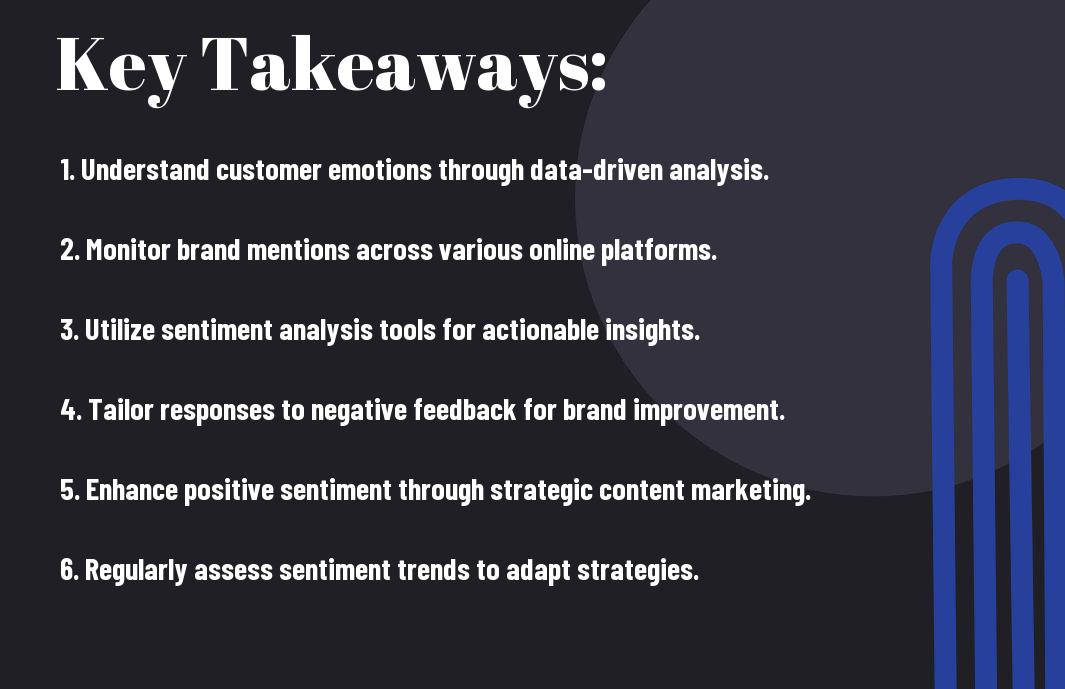Over time, effective Online Reputation Management (ORM) has become imperative for businesses, leading SEO agencies to integrate sentiment analysis into their strategies. They must recognize the impact that public opinion has on brand perception and take significant steps to analyze sentiments conveyed through social media, reviews, and various digital platforms. This post will explore how she can utilize sentiment analysis tools to gauge customer emotions, enabling important adaptations and improvements in their ORM efforts. Consequently, they enhance brand loyalty and mitigate potential reputational threats effectively.

Key Takeaways:
- Utilize sentiment analysis tools to gauge public perception of brands, enabling targeted strategies for online reputation management (ORM).
- Regularly monitor social media platforms and online reviews to identify patterns in customer sentiment, allowing for timely interventions in ORM efforts.
- Incorporate sentiment analysis data into content creation, ensuring messaging aligns with audience emotions and addresses concerns effectively.
- Engage with customers in response to sentiment findings, fostering transparency and building trust within the community.
- Continuously refine ORM strategies based on sentiment trends, adapting to shifts in consumer attitudes and enhancing overall brand image.
Understanding Sentiment Analysis
While navigating the complex landscape of online reputation management (ORM), SEO agencies must grasp the nuances of sentiment analysis. This powerful tool allows professionals to measure public emotions and opinions tied to a brand, product, or service. By analyzing content across social media, reviews, and other digital platforms, they can discern positive, negative, or neutral sentiments that inform strategic decisions. Understanding sentiment analysis is vital for effective ORM, shaping how agencies interact with audiences.
Definition of Sentiment Analysis
To define sentiment analysis, it can be understood as the computational method of identifying and categorizing emotions expressed in textual data. By utilizing natural language processing (NLP) and machine learning algorithms, it offers agencies insights into consumer opinions and feelings about specific topics. Sentiment analysis can be performed on various forms of content, from social media posts to customer reviews, enabling a holistic view of public sentiment.
To engage in effective sentiment analysis, one must consider both the qualitative and quantitative data it provides. They can gather insights related to brand reputation, competitor actions, and market trends while also understanding the deeper emotional context behind customer feedback. This dual approach allows agencies to pivot their marketing strategies according to prevailing sentiment and emerging trends.
Importance of Sentiment Analysis in Digital Marketing
Around the digital marketing landscape, sentiment analysis has proven to be a key driver for success. It offers insights that can influence campaign strategies, product development, and customer service initiatives. By identifying customer attitudes and preferences, SEO agencies can tailor their messaging to resonate more effectively with their target audience, ensuring a higher engagement rate and improved conversion strategies.
At the heart of digital marketing lies the necessity for brands to engage with their audiences not just logically but emotionally. Sentiment analysis assists in painting a vivid picture of consumer attitudes, enabling agencies to strategically align their campaigns with the values and sentiments of their audience. This alignment fosters deeper connections, enhances brand loyalty, and positions businesses favorably within their competitive landscape.
Types of Sentiment Analysis Techniques
Sentiment analysis techniques vary in approach, yet they all aim to translate textual data into measurable sentiment. Some prevalent techniques he might explore include:
- Lexicon-Based Analysis: This method relies on predefined lists of words and phrases classified as positive, negative, or neutral.
- Machine Learning Approaches: Using algorithms, this technique trains models on labeled data to improve sentiment classification accuracy.
- Natural Language Processing (NLP): NLP empowers computers to understand and interpret human language, enhancing sentiment detection.
- Automated Sentiment Classification: This technique automates the categorization of sentiments in vast datasets, streamlining the analysis process.
- Aspect-Based Sentiment Analysis: This advanced method evaluates sentiments on specific attributes or aspects of a product or service.
After examining these techniques, they discover a rich array of methodologies available for both novice and expert practitioners in the field of sentiment analysis.
| Technique | Description |
| Lexicon-Based Analysis | Utilizes predefined emotion lexicons. |
| Machine Learning Approaches | Employs algorithms trained on labeled data. |
| Natural Language Processing (NLP) | Permits computers to interpret human language. |
| Automated Sentiment Classification | Facilitates sentiment categorization in large datasets. |
| Aspect-Based Sentiment Analysis | Focuses on sentiments directed at specific product aspects. |
Plus, agencies can enhance their effectiveness by incorporating sophisticated algorithms and deep learning techniques, which offer higher precision in analyzing sentiments across varying contexts. By leveraging these advanced methods, she can sift through vast amounts of data, extracting key sentiment insights pertinent to ORM.
Tools and Software for Sentiment Analysis
One of the significant aspects of sentiment analysis involves choosing the appropriate tools and software solutions for accurate insights. He might explore platforms like Hootsuite, Brandwatch, and Google Analytics, which provide a range of features for monitoring and analyzing sentiment across digital channels. These tools facilitate easy tracking of brand mentions and sentiments, greatly simplifying the ORM process.
One advantage of using these tools is their ability to deliver real-time insights, allowing agencies to respond swiftly to emerging trends or potential crises. Furthermore, they often come equipped with advanced reporting features, enabling efficient presentation of sentiment data to stakeholders. This real-time capability is vital for immediate intervention when negative sentiment arises.
And as sentiment analysis continuously evolves, it remains imperative for SEO agencies to stay updated on the latest tools and technologies at their disposal. By doing so, they can enhance their ORM strategies, ensuring they maintain a competitive edge while fostering positive relationships with consumers.


The Role of ORM (Online Reputation Management)
For any SEO agency, understanding the role of Online Reputation Management (ORM) is pivotal in shaping their strategies. ORM serves as a profound tool for forecasting how a brand is perceived online, which influences both customer trust and engagement. By efficiently managing online reviews and feedback, agencies can enhance their clients’ reputation, ultimately driving business growth. Engaging effectively with ORM strategies can create a foundation, ultimately guiding agencies in improving their clients’ visibility and credibility. For a deeper insight into the connection between ORM and SEO, refer to this resource on Online Reputation Management and SEO.
Defining ORM
By definition, Online Reputation Management involves monitoring and influencing how individuals and companies are perceived on the internet. It encompasses various activities such as responding to reviews, engaging in social media, and promoting positive content to overshadow any negative views. ORM ensures that when consumers search for a brand, they encounter the most favorable information available. This intricate measure helps businesses build credibility, and sustain a positive image in an increasingly competitive digital landscape.
ORM is not merely about handling negative feedback; it is about creating a narrative that aligns with a company’s goals and values. By focusing on customer satisfaction and engagement, ORM can cultivate a robust online presence, striking a balance between monitoring and influencing public perception. This makes ORM an integral part of a business’s digital marketing strategy, especially in an era where online sentiment can make or break a brand.
The Impact of ORM on Business Success
Management of online reputation directly correlates with business success. A positive online presence can enhance customer trust, boost sales, and foster brand loyalty. In contrast, any negative sentiment if left unchecked, can significantly deter potential customers and tarnish a brand’s image. As consumers increasingly rely on online reviews and social proof before making purchasing decisions, the way brands manage their reputation can have far-reaching consequences.
But the impact does not stop at just consumer behavior; it extends to partnerships and professional relationships. A company known for its positive reputation is more likely to attract strategic partnerships and collaborations. Thus, ORM can be viewed as a vital investment that predicts future business performance, ensuring sustainability and growth in the marketplace.
Key Components of Effective ORM
Business entities engaged in ORM must utilize a structured approach that includes monitoring brand mentions across various platforms, responding promptly to customer inquiries, and generating positive content. By prioritizing transparency and authenticity, companies can foster trust with their audience, paving the way for constructive interactions. These components work synergistically to cultivate a positive image that resonates with consumers.
For instance, establishing a dedicated team or utilizing advanced software tools can facilitate real-time monitoring of online sentiment. This proactive stance enables organizations to address issues before they escalate, thus enhancing overall customer satisfaction. Additionally, gathering data from sentiment analysis can equip businesses with insights to refine their strategies further.
Integrating Sentiment Analysis in ORM Strategies
Online sentiment analysis plays an crucial role in ORM, allowing agencies to grasp public perception accurately. By utilizing advanced analytical tools, they can interpret customer feedback and identify trends, shaping effective ORM strategies tailored to their clients’ needs. This integration will enable agencies to strategize more precisely, focusing on areas that demand improvement or enhancement. Consequently, informed decisions can be made to cultivate a favorable online presence that resonates with consumers.
Plus, gaining insights from sentiment analysis can significantly amplify ORM efforts. It allows agencies to not only assess how a brand is being perceived but also understand the emotional drivers behind customer sentiments. By merging ORM with sentiment analysis, they empower their clients to craft responses that are empathetic, timely, and contextually relevant, ultimately fostering a positive dialogue with their audience.
Identifying Sentiment Trends
Not many SEO agencies fully grasp the potential of sentiment analysis in managing online reputation. By identifying sentiment trends, they can gain valuable insights that inform their marketing strategies and enhance their ORM efforts. This process involves sifting through various data sources to uncover customer perceptions and emotional responses relevant to a brand.
Data Sources for Sentiment Analysis
Trends in sentiment analysis can be drawn from various data sources, including customer feedback channels, social media platforms, and review sites. These sources provide a wealth of information that agencies can analyze to gauge how their clients are perceived in the marketplace. Popular platforms such as Twitter, Facebook, and Google Reviews serve as treasure troves for sentiment data, enabling them to capture both positive and negative sentiments effectively.
Analyzing Customer Reviews and Feedback
Among the most telling indicators of sentiment are customer reviews and feedback. These reviews not only reflect customer satisfaction but also highlight areas for improvement. By systematically analyzing these reviews, one can identify specific issues that customers face, as well as the consistent themes in their feedback, whether it’s related to product quality, service speed, or overall experience.
In addition, the language used in reviews can reveal underlying emotions, making it imperative for agencies to pay close attention to tone and specific word choices. This detailed analysis allows them to discern broader sentiment trends, ensuring they address concerns effectively while enhancing positive sentiments that resonate with customers.
Monitoring Social Media Sentiment
Identifying sentiment on social media is pivotal for understanding public perception. By closely monitoring platforms such as Instagram, Twitter, and LinkedIn, agencies can stay abreast of the sentiments surrounding their clients. Social media sentiment can change rapidly, necessitating ongoing monitoring to capture the latest emotional responses from the audience.
Understanding social media sentiment also allows agencies to respond proactively. By analyzing real-time conversations, they can spot potential crises before they escalate and engage with customers in meaningful ways to foster positive interactions, thus enhancing their clients’ online reputation.
Leveraging Competitor Sentiment for Strategy
Among the powerful strategies that agencies can implement is leveraging competitor sentiment. By analyzing how customers feel about competitors, they can present their clients in a favorable light, emphasizing strengths while addressing weaknesses. Understanding competitor sentiment empowers them to position their brand strategically in the market, capitalize on opportunities, and mitigate threats effectively.
Hence, they can use competitor sentiment analysis to refine their messaging and marketing campaigns, ensuring they align with customer expectations while differentiating themselves from their rivals. This approach not only enhances their own ORM but also contributes to a stronger brand presence in a saturated market.
Strategies for Implementing Sentiment Analysis
Many agencies understand the significance of employing sentiment analysis in their Online Reputation Management (ORM) efforts. It provides them valuable insights into public perception regarding a brand, product, or service. However, without a structured approach, they may struggle to harness the full potential of sentiment analysis. Establishing effective strategies is crucial for successful implementation.
Setting Clear Objectives
For any agency looking to leverage sentiment analysis, the first step is to define clear objectives. This involves identifying what they wish to achieve, whether it’s improving brand perception, responding to customer feedback, or monitoring specific campaigns. By setting measurable goals, such as tracking sentiment changes over time or assessing responses to promotional efforts, agencies can focus their analysis effectively.
Additionally, he or she should prioritize key performance indicators (KPIs) relevant to their objectives. Understanding the expected outcomes ensures that the sentiment analysis efforts focus on the right metrics and provide actionable insights that lead to tangible results.
Choosing the Right Tools for Analysis
Behind every successful sentiment analysis initiative is a suite of powerful tools designed to sift through vast amounts of data. Selecting the right tools is crucial, as the effectiveness of sentiment analysis heavily depends on both the technology used and the dataset being analyzed. Agencies should consider tools that not only offer advanced sentiment detection but also provide contextual understanding.
But the options can be overwhelming. Agencies must evaluate potential tools based on their specific needs, available budget, and the types of data they intend to analyze. Some tools provide comprehensive social listening capabilities, while others may focus solely on analytics. A thorough review of features, ease of use, and customer support is imperative in making an informed choice.
Developing a Data Integration Plan
To maximize the benefits of sentiment analysis, agencies should develop a robust data integration plan. This involves combining data from multiple sources, including social media platforms, review sites, and direct customer feedback. By aggregating data effectively, they can glean a holistic view of public sentiment and recognize patterns that might not be evident from isolated data points.
Importantly, the integration plan should also ensure data accuracy and relevance. By implementing processes that systematically update and maintain data quality, he or she ensures that analyses are based on sound information, leading to better decision-making.
Training the Team on Sentiment Analysis
One of the critical steps in adopting sentiment analysis effectively is training the team. He or she needs to ensure that the team possesses the necessary skills and knowledge to interpret sentiment analysis results accurately. Providing regular training sessions on data interpretation, sentiment detection algorithms, and pertinent tools can enhance their proficiency in leveraging insights for ORM.
The training can involve interactive workshops, webinars, and practical case studies, allowing the team to apply what they learn in real-world scenarios. This investment in team development will empower them to utilize sentiment analysis fully and contribute to the agency’s overall reputation management strategy.
Training programs should also cover the nuances of sentiment analysis, such as understanding sarcasm or contextual sentiment. As these elements are often overlooked, this additional focus will deepen their analytical skills and ultimately enhance the agency’s ORM efforts.
Case Studies of Successful ORM through Sentiment Analysis
Now, let’s examine a few case studies where agencies successfully utilized sentiment analysis for effective online reputation management (ORM). These examples highlight the potential impact of sentiment analysis on enhancing brand image and customer engagement:
- Brand A: After a significant product recall, Brand A engaged in a comprehensive sentiment analysis, which revealed a disparity between customer perception and actual product safety. By addressing customer concerns and improving communication, the brand reduced negative sentiment by 65% within three months.
- Company B: Following a public relations crisis, Company B employed sentiment analysis to gauge public response. By quickly addressing concerns raised in social media conversations, Brand B saw a 50% increase in positive feedback over the subsequent quarter.
- Organization C: Utilizing sentiment analysis tools, Organization C identified a trend of negative feedback related to their customer service. They overhauled their service operations based on customers’ sentiments, leading to a 40% increase in customer satisfaction ratings within six months.
- Startup D: Startup D introduced a product but faced backlash due to misunderstandings about its features. By analyzing sentiment around feedback, they promptly adjusted marketing strategies, resulting in a dramatic 70% increase in positive sentiment shortly thereafter.
Industry-specific Examples
At the level of industry-specific examples, the application of sentiment analysis can vary greatly. In the hospitality sector, for instance, a hotel chain used sentiment analysis to monitor reviews across platforms like TripAdvisor and Yelp. By acting on common complaints about cleanliness, they not only managed to enhance their reputation, but their star ratings improved by 1.2 stars within just one year. Similarly, in the media industry, a news platform utilized sentiment analysis to track audience reactions to their reporting. This enabled them to pivot content strategies in real-time, resulting in a 30% increase in readership engagement.
At the same time, retail businesses are harnessing sentiment analysis to improve customer interactions. One major retailer used the insights gained from customer feedback to redesign their store layout and optimize their product offerings. Consequently, they reported a notable 15% increase in in-store sales, showcasing the benefits of responsive actions based on sentiment analysis.
Lessons Learned from Successful Agencies
Analysis of successful agencies reveals several key takeaways. Agencies that effectively leveraged sentiment analysis often prioritized continuous monitoring of customer feedback. By maintaining an ongoing dialogue with their audience, they could adapt strategies and messages quickly to resonate with customer sentiments, leading to improved ORM outcomes. In one instance, a top agency utilized sentiment analysis to flag emerging issues before they escalated, thus maintaining a positive brand image long-term.
With regular engagement and analysis of sentiment data, agencies also discovered the importance of focusing on a customer-centric approach. By tailoring responses to nuanced feedback and fostering an open communication channel, they not only mitigated negative sentiments but also built stronger loyalty amongst their customer base. This dual strategy of proactive and reactive management forms the backbone of effective ORM through sentiment analysis.
Common Pitfalls and How to Avoid Them
To achieve successful ORM through sentiment analysis, one must be aware of common pitfalls that can derail the process. Some organizations may underestimate the complexity of sentiment data and the necessity for nuanced interpretation. Without a deep understanding, they risk making poor decisions based on misleading data. Moreover, failing to integrate sentiment analysis into broader marketing strategies can result in missed opportunities for optimizing brand messages and addressing consumer pain points.
A thorough evaluation of sentiment data is imperative. Agencies must ensure they leverage advanced analytics tools and techniques for accurate interpretation. They must also invest in training team members to understand the intricacies of sentiment analysis, allowing them to create actionable strategies based on the data at hand, rather than superficial interpretations.
Measuring the Impact of Sentiment Analysis on ORM
After implementing sentiment analysis into their Online Reputation Management (ORM) strategies, an SEO agency must evaluate the effectiveness of these efforts. This assessment is vital in understanding how sentiment analysis can shape their ORM approach. It not only provides insights into the reception of a brand but also informs adjustments needed to enhance their reputation across various platforms.
Key Performance Indicators (KPIs) to Track
By establishing a set of Key Performance Indicators (KPIs), agencies can accurately gauge the impact of sentiment analysis on ORM effectiveness. Essential KPIs may include sentiment score trends, engagement metrics, and the volume of positive versus negative mentions across media channels. Monitoring these metrics helps in assessing whether sentiment analysis leads to favorable shifts in brand perception.
Additionally, tracking conversion rates can serve as a powerful indicator of how sentiment influences customer decisions. Through careful examination of these KPIs, SEO professionals can identify patterns and correlations that guide their ORM strategies, reinforcing initiatives that yield positive results and revisiting those that do not.
Analyzing Business Outcomes
Track the business outcomes that result from implementing sentiment analysis within ORM initiatives. This process involves correlating sentiment data with key business metrics, such as customer acquisition rates, retention rates, and overall sales growth. By observing these outcomes, they can discern the tangible impacts of positive or negative sentiment on the business as a whole.
Analyzing the business outcomes further reveals how sentiment-driven strategies can enhance customer relationships. Companies that actively engage with customer feedback are often able to pivot and adapt their offerings according to customer needs, leading to improved customer loyalty and sustained revenue growth.
Continuous Improvement through Feedback Loops
By instituting feedback loops, SEO agencies can facilitate ongoing refinement of their ORM strategies. Incorporating real-time data from sentiment analysis enables them to adjust their approaches swiftly, responding to shifts in public opinion. Engaging with consumers through follow-up surveys or social media interactions can yield invaluable insights that inform future ORM tactics.
Impact is realized when agencies utilize feedback loops effectively, continuously improving their ORM initiatives based on sentiment analysis data. This iterative process not only strengthens brand loyalty but also enhances a company’s image, as they show responsiveness to customer concerns and preferences. In the long run, these feedback mechanisms foster a culture of adaptability, vital for maintaining a positive online presence.
Summing up
Summing up, an SEO agency can significantly enhance its strategy in online reputation management (ORM) by effectively leveraging sentiment analysis. By integrating advanced analytical tools, they can gauge consumer perceptions, track sentiment trends, and respond proactively to public opinion. Through an in-depth understanding of the sentiment surrounding a brand, they empower their clients to craft targeted messages and resolve potential crises before they escalate. This strategic approach not only aids in restoring or building a positive brand image but also fosters trust and loyalty among consumers.
Furthermore, the implementation of sentiment analysis should be complemented with regular reporting and feedback loops to refine ORM strategies continually. It is important that they stay abreast of shifts in public sentiment to adapt their ORM tactics accordingly. By educating clients on the significance of ORM alongside sentiment analysis, agencies lay the groundwork for sustainable brand reputation management. For a deeper examine the challenges associated with ORM and how to navigate them, they can refer to ORM: Its Hurdles and How to Overcome Them.
FAQ
Q: What is sentiment analysis and why is it important for an SEO agency?
A: Sentiment analysis is the process of determining the emotional tone behind a series of words, used to gain an understanding of the attitudes, opinions, and emotions expressed in online content. For an SEO agency, it’s important because it allows for effective Online Reputation Management (ORM) by identifying how a brand is perceived in the digital space. By analyzing customer sentiment, agencies can respond to negative feedback promptly, create positive narratives, and enhance brand perception.
Q: How can sentiment analysis enhance content marketing strategies?
A: Sentiment analysis can inform content marketing strategies by identifying what types of content resonate most with the target audience. By analyzing customer feedback and social media interactions, SEO agencies can tailor their messaging, promote products that align with customer sentiments, and create content that addresses consumer needs. This targeted approach helps increase engagement and can positively impact search engine rankings.
Q: What tools and technologies can an SEO agency use for sentiment analysis?
A: There are several tools available for conducting sentiment analysis, including natural language processing (NLP) technologies and software like Google Cloud Natural Language, IBM Watson, and Brandwatch. These tools use algorithms to parse large datasets, detect sentiment, and provide insights. SEO agencies should choose tools that integrate well with their existing systems and that can provide actionable insights into customer perceptions.
Q: How often should sentiment analysis be performed for effective ORM?
A: The frequency of sentiment analysis should depend on the volume of brand mentions and the dynamism of the market. For active brands, conducting sentiment analysis on a weekly basis may be beneficial, while less active brands may find monthly assessments sufficient. Continuous monitoring allows agencies to promptly address negative sentiment trends and actively manage the brand’s online reputation.
Q: What steps should an SEO agency take after conducting sentiment analysis?
A: After conducting sentiment analysis, an SEO agency should analyze the data to identify key trends and concerns raised by customers. They should develop an action plan that addresses negative sentiments, engages with customers to clarify misunderstandings, and promotes positive aspects of the brand. Additionally, they should track the effectiveness of their responses and adjust strategies as necessary to ensure continuous improvement in public perception.


